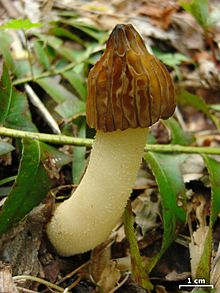
Morchella esculenta is a species of fungus in the family Morchellaceae of the Ascomycota. It is one of the most readily recognized of all the edible mushrooms and highly sought after. Each fruit body begins as a tightly compressed, grayish sponge with lighter ridges, and expands to form a large yellowish sponge with large pits and ridges raised on a large white stem. The pitted yellow-brown caps measure 2–7 centimetres broad by 2–10 cm (1–4 in) tall, and are fused to the stem at its lower margin, forming a continuous hollow. The pits are rounded and irregularly arranged. The hollow stem is typically 2–9 cm long by 2–5 cm (1–2 in) thick, and white to yellow. The fungus fruits under hardwoods and conifers during a short period in the spring, depending on the weather, and is also associated with old orchards, woods and disturbed grounds.

Gymnopilus luteofolius, known as the yellow-gilled gymnopilus, is a large and widely distributed mushroom that grows in dense clusters on dead hardwoods and conifers. It grows in late July to November in the east and in the winter on the west coast of North America. It has a rusty orange spore print and a bitter taste.

Gyromitra caroliniana, known commonly as the Carolina false morel or big red, is an ascomycete fungus of the genus Gyromitra, within the Pezizales group of fungi. It is found in hardwood forests of the southeastern United States, where it fruits in early spring soon after snowmelt.

Psilocybe caerulescens, also known as landslide mushroom, is a psilocybin mushroom having psilocybin and psilocin as main active compounds. Along with Psilocybe mexicana and Psilocybe aztecorum, it is one of the mushrooms likely to have been used by the Aztecs and is currently used by Mazatec shamans for its entheogenic properties.
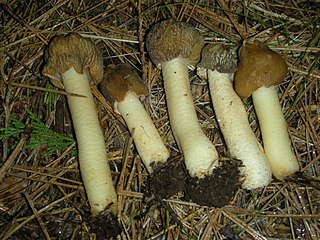
Verpa conica, commonly known as the bell morel or the early morel, is a species of fungus in the family Morchellaceae. Sometimes mistaken for a true morel, this species is characterized by a cap resembling a thimble that is freely attached to the stipe.

Verpa bohemica is a species of fungus in the family Morchellaceae. The synonym Ptychoverpa bohemica is often used by European mycologists and it is commonly known as the early morel or the wrinkled thimble-cap. The mushroom has a pale yellow or brown thimble-shaped cap—2 to 4 cm in diameter by 2 to 5 cm long—that has a surface wrinkled and ribbed with brain-like convolutions. A feature distinguishing the species from true morels, the cap hangs free from the top of the stem, which is lighter in color, brittle, and up to 12 cm long by 1 to 2.5 cm thick. Microscopically, the mushroom is distinguished by its large spores, typically 60–80 by 15–18 µm, and the presence of only two spores per ascus.

Agaricus dulcidulus is a small mushroom in the family Agaricaceae of the order Agaricales, found in deciduous woodlands of Europe, but also recorded in North America, North Africa and Asia. The English name is rosy wood mushroom. Despite the tendency of some sources to synonymize it with Agaricus semotus, this is a distinct taxon.

Morchella rufobrunnea, commonly known as the blushing morel, is a species of ascomycete fungus in the family Morchellaceae. A choice edible species, the fungus was described as new to science in 1998 by mycologists Gastón Guzmán and Fidel Tapia from collections made in Veracruz, Mexico. Its distribution was later revealed to be far more widespread after several DNA studies suggested that it is also present in the West Coast of the United States, Israel, Australia, Cyprus, Malta and Switzerland.

Morchella tridentina is a cosmopolitan species of ascomycete fungus in the family Morchellaceae. Commonly referred to as the mountain blond or western blond morel in North America, it produces conical, grey to buff fruit bodies that are rufescent and grow up to 20 cm (7.9 in) tall and 5 cm (2.0 in) wide. This early-diverging species is distinct within the /Elata clade due to its pale colours and has been described by many names in the past, including M. frustrata, M. quercus-ilicis, M. elatoides, M. elatoides var. elegans and M. conica var. pseudoeximia, all of which were shown to be synonyms. A widely distributed relict of the last Ice Age, M. tridentina is so far known from Argentina, Armenia, Chile, Cyprus, France, India, Israel, North America, Spain and Turkey.
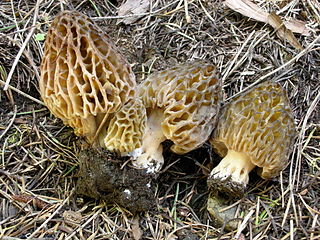
Morchella snyderi is a species of fungus in the family Morchellaceae. Described as new to science in 2012, it occurs in the montane forests of western North America, including California, Idaho, Montana, Oregon and Washington. It produces fruit bodies up to 14 cm (5.5 in) tall with ridged and pitted conical caps, and stipes that become pitted in maturity. The color of the morel is yellow to tan when young, but the cap ridges become brown to black in maturity or when dried.

Morchella importuna is a species of fungus in the family Morchellaceae described from North America in 2012. It occurs in gardens, woodchip beds, and other urban settings of northern California and the Pacific Northwest region of the United States and Canada. The fungus has also been reported from Turkey, Spain, France, Switzerland, Canada and China, although it is unknown whether this is a result of accidental introductions. It is considered a choice edible mushroom. The fruit bodies develop a distinctive ladder-like pattern of pits and ridges on the surface of their conical caps.
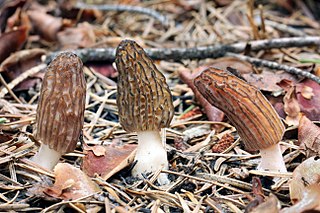
Morchella sextelata is a species of ascomycete fungus in the family Morchellaceae. Described as new to science in 2012, it is found in North America. It has also been found in China, although it is not known if this is a result of an accidental introduction or natural dispersion. The fruit bodies have a roughly conical cap up to 7.5 cm (3 in) tall and 5 cm (2 in) wide, with a surface of mostly vertically arranged pits. The cap is initially yellowish to brownish, but it darkens to become almost black in maturity. The stipe is white and hollow, measuring 2–5 cm (0.8–2.0 in) high by 1–2.2 cm (0.4–0.9 in) wide.

Morchella populiphila is a species of morel fungus native to northwestern North America. Described as new to science in 2012, its specific epithet refers to its association with black cottonwood. The morel used to be referred to as Morchella semilibera in western North American field guides until molecular analysis established that to be a strictly European species. M. populiphila occurs in California, Nevada and Oregon. Its fruit bodies grow up to 15 cm (6 in) tall with a ridged and pitted conical cap that attaches about halfway down the stipe. The cap ridges are dark brown to black in maturity, while the pits are yellowish to brownish. The fungus is edible, although not as highly valued as other morels.
Morchella deqinensis is a species of fungus in the family Morchellaceae found in China. It grows in coniferous and mixed forests at an elevation of 2,800–3,200 m (9,200–10,500 ft).
Morchella meiliensis is a species of fungus in the family Morchellaceae native to China.

Pholiota nubigena, commonly known as the gastroid pholiota or the bubble gum fungus, is a species of secotioid fungus in the family Strophariaceae. It is found in mountainous areas of the western United States, where it grows on rotting conifer wood, often fir logs. It fruits in spring, often under snow, and early summer toward the end of the snowmelt period in high mountain forests. Fruit bodies appear similar to unopened mushrooms, measuring 1–4 centimetres tall with 1–2.4 cm diameter caps that are whitish to brownish. They have a short but distinct whitish stipe that extend through the internal spore mass (gleba) of the fruit body into the cap. The gleba consists of irregular chambers made of contorted gills that are brownish in color. A whitish, cottony partial veil is present in young specimens, but it often disappears in age and does not leave a ring on the stipe.

Morchella anatolica is a rare species of ascomycete fungus in the family Morchellaceae. It was described as new to science in 2010 from southwest Anatolia, Turkey, where it grows on moss-covered stream beds in pine forests. An ancient climatic relict, M. anatolica is restricted to the Mediterranean basin and has also been documented in Spain, Cyprus and Greece, where it is sometimes encountered with trees of the Oleaceae family. Together with its sister-species Morchella rufobrunnea, they are the earliest diverging lineages in genus Morchella, forming a distinct clade that is basal in global morel phylogenies. Because of its phylogenetic position, M. anatolica has been crucial in inferring the historical biogeography of the genus, which is estimated to have emerged somewhere in the Mediterranean region in the late Jurassic.

Morchella arbutiphila is a species of fungus in the family Morchellaceae (Ascomycota), described from the island of Cyprus in 2016. The species is notable for its elongated stipe, which is often longer than the cap's length, its ascospores which are larger than most other species of Morchella, and its highly specific ecological preferences. It is known only from igneous substrates of the Troodos mountains in Cyprus and from a single collection in the Aegean region of Turkey.
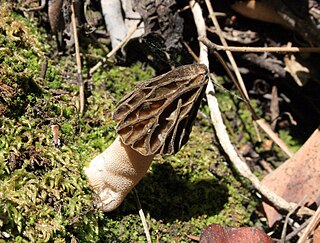
Morchella disparilis is an Ascomycete fungus in the family Morchellaceae. Described as new to science in 2016, M. disparilis appears to be confined to the Mediterranean basin and is so far known from Cyprus, Greece and Spain. Its most striking feature is the exceptionally deep sinus, intermediate in depth between half-free morels of the Morchella semilibera clade and typical Distantes species.
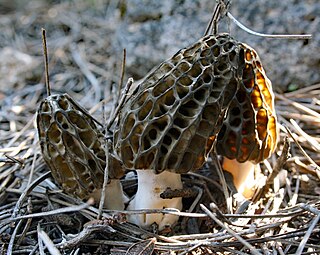
Morchella dunalii is a species of fungus in the family Morchellaceae (Ascomycota). A widespread species in the Mediterranean basin, M. dunalii is so far known from the Balearic islands, the islands of Corsica and Cyprus, France, Spain and Turkey, where it appears to be abundant. It fruits very early in the season on calcareous soil, usually in association with the Aleppo pine, Calabrian pine and holm oak.
